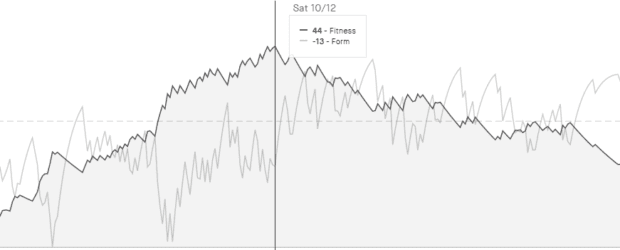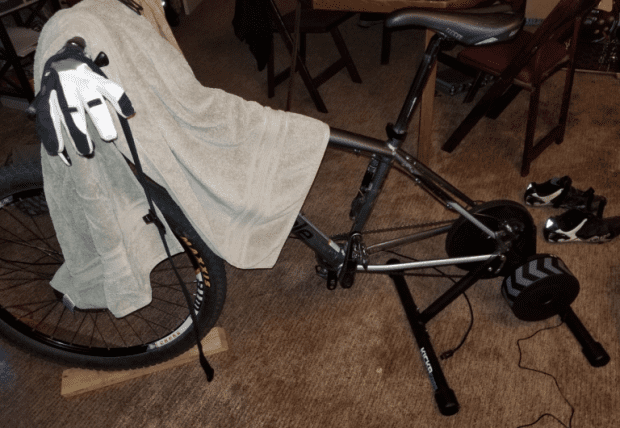Mountain Biking at 50: The Winter Months
Winter is cold, harsh and foreboding for endurance athletes, but it does exist and we have to work through it – so how does a 50-year-old cross country mountain biking athlete do that?
My plan has always been to run several races in 2020 with a goal to take a medal in my class. Over the winter, I spent time to de-train and am now ramping up for the race season.
So, what did I do over the winter to train/detrain?
First, reducing volume and intensity of my rides was critical. This is the time to get rid of all the fatigue and stress built up in my body over a the last several months. Using Strava’s fitness and freshness tool, you can see how after the summer, I started to detrain:

There were no races to train for, no reason to take the stress into the winter so I backed off. But, I still needed to do some training even as the weather got a LOT wetter and certainly colder. Enter: The indoor trainer and training apps.
I received a Wahoo Kickr Core direct drive trainer for Christmas and it could not have come at a better time. Not only did it allow me to ride when the weather had closed the trails, but it allowed me to train with power, instead of just heart rate and rate of perceived exertion (RPE), I was able to accurately measure my FTP and do specific workouts where particular power output was needed at specific times.

Now, I didn’t go straight into race training in January. I was intentionally de-training to give my older joints a break and to allow me to get psychologically excited about training once Spring got closer. This was my anti-burnout time. But towards the end of February, the rain let up, the trails were starting to be open more often and I was getting the itch… then I got the flu, coronavirus, dunno, it just sucked. But a week later, I had recovered and got back on the trainer with a renewed sense of urgency as the race season was closing in.

I first paired the Kickr with Zwift. I’m a gamer and the gamey approach appealed to me .. at first. Don’t get me wrong – Zwift was fun, a good way to go riding when the weather stinks, and has a social aspect that might help to motivate some athletes. I … didn’t need that and I found the workouts lacking.
I did the 20 minute FTP test to establish a base that the workouts and plans use to adjust the difficulty. I started one FTP building plan and after several workouts just found the rides to be too easy. I then switched to a mountain bike specific plan and could not finish the first workout.. not even close. The problem is that the plans all come from different “coaches” without a central approach to training. Each coach does their own thing and makes their own workouts. This didn’t make me want to do any more of the workouts, but instead, I just changed my FTP inside Zwift by a ridiculous amount and went back to the FTP builder plan. That didn’t give me a great deal of confidence.
Then, I started watching the “Ask a Cycling Coach” podcasts on Youtube by TrainerRoad and was fascinated by the details, information and science the coaches used to describe workouts, solve problems and attack weaknesses. After a few weeks of watching, the Zwift membership got axed and TrainerRoad (TR) got my training dollars and although I’m only in week two of my plan, holy crap this is a difference-maker if you are trying to train seriously.
Immediately, the difference between Zwift and TR because evident. The first thing I needed to do was create my training calendar. I entered the races I was planning to enter, tell it what kind of race it is (Cross Country Olympic for me), add in estimated race length, how hard I plan to go during the event (training stress) and categorize the races as A (primo event), B (training event), or C (fun race). Then… the program built an entire training plan specifically built for my race calendar. It’s like having a coach on your computer.
The first thing on my calendar was a ramp test. I did have a challenge with TR in doing the test using the Windows app. I had connected the kicker, my heart rate monitor and cadence monitor to Zwift on the PC when I was using that program. I used an ANT+ USB dongle on a 6ft USB extension cable to keep the dongle next to the trainer and hence all the devices. It worked fine for Zwift. I started out with the same setup for TrainerRoad, but with not so great results. I liked using the PC app because I have a large monitor and even with my glasses off, I could read the instructional text at the bottom of the workout screen. So I got everything paired to TR and proceeded to do the ramp test, which is how TR figures out your threshold power. A few minutes into the test, my cadence sensor unpaired, the app thought I had already quit. I had to get off the trainer, re-pair, then get back on. A few minutes later, the Kickr lost pairing and turned resistance to zero… . This repeated for a few more minutes until I gave up and quit. I didn’t want to screw up my training plan and although I had a little fatigue built up, decided to install the android TR app, pair my devices to that and retry the ramp test – the same night. The mobile app worked flawlessly, I finished the test, and felt that the FTP calculation that it made was close enough to start training.
The TR workouts are more focused on working on the energy systems and cycling mechanics that matter. In week one, I did a workout (Ericsson) that was focused on spin speed increases and the first thing it did was walk me through isolated leg training (pedaling with one leg at a time to smooth out the stroke.) That has made a huge difference in the perceived effort during other efforts. There are constant tips on how to relax during intense efforts, how to focus on breathing when you think you’re about to die, and almost perfectly timed positive comments when giving up on the workout enters your mind.
The Kickr Core + TrainerRoad also gives me the ability to keep up my Spring training even when the trails are closed due to rain and now I often choose to train indoors when the planned workout doesn’t lend itself to trails and I don’t have flat roads in my area… at all.
So if you’re a mountain biker dealing with bad weather, roads that don’t let you train like you need to, and want some expert guidance to plan your season, get a trainer, look at TrainerRoad.
Experts worth watching:
- Dylan Johnson
- TrainerRoad: Ask a Cycling Coach Podcast




